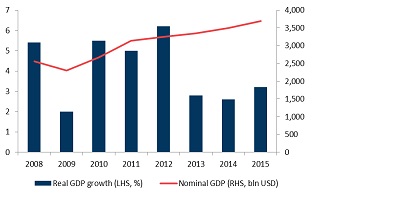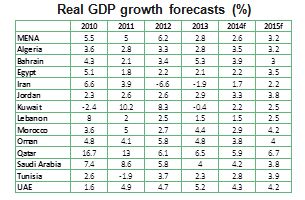Top Stories
MIDDLE EAST AND NORTH AFRICA REGION: WHAT PROGRESS AFTER THE “ARAB SPRING”?

- Economic activity is gaining strength in Middle East and North Africa region
- Strong growth momentum in GCC countries continue, economic recovery in oil importers is on track
- Oil exporters successfully diversified their economies, but they are still heavily dependent on hydrocarbon sector in terms of budget and export revenues
- Oil importers face higher risks of geopolitical tensions
- Morocco and Tunisia seen benefiting from European recovery, higher political stability
After a period of political and social turmoil, the economic activity is gaining strength in the Middle East and North Africa region. The growth is expected to stand at 2.6 percent in 2014 and to accelerate to 3.2 percent in 2015 on the back of global economic recovery and preliminary signs of political consensus in some countries of the region. However the growth performance will continue to stand below the 2000-2010 average of 5.4 percent.
Middle East and North Africa region growth performance
The GCC countries are expected to grow 4.2 percent in 2014 and 4.1 percent in 2015, leading the economic growth in the region on the back of robust non-hydrocarbon activities and large budget surpluses. The diversification policies helped the GCC region to support the non-hydrocarbon industries. Overall in GCC countries, the share of the hydrocarbon sector’s contribution to GDP declined from 41 percent in 2000 to 33 percent in 2014. These countries also benefit from solid financial fundamentals such as huge assets in their sovereign wealth funds and external surpluses. However the sharp decline in oil prices would weigh on growth performances and fiscal balances in 2015.
On the oil importers (Egypt, Jordan, Lebanon, Morocco, Tunisia) side, the recovery in tourism, investor’ confidence and exports, supported by the recovery in European countries, are expected to contribute positively to the growth performance. Besides, many oil importing countries have announced stimulus packages to support the economic activity in the aftermath of social unrests. Oil importers are expected to grow 2.5 percent in 2014 and 3.4 percent in 2015. Yet these countries suffer from high unemployment, budget and current account deficits. The public debt levels are still high. However the situation is expected to improve on the back of recovery in economic activity and the incentive reforms.
On the other hand the regional turmoil would weigh heavily on the economic performance of some countries like Iraq and Libya. Iraq and Libya are expected to contract 2.5 percent and 19.8 percent respectively in 2014.
“The divergence between the oil exporters and oil importers persists and the real growth rates remaining below the 2000-2010 average for both groups. Nevertheless most of the GCC countries were able to stay out of the geopolitical tensions which allowed them to continue to attract foreign investments and record solid growth rates. They continue to invest heavily in non-oil sectors to transform their economies. This also reduces their vulnerability to a sharp decline in energy prices. Therefore Coface assessments of business environment are better in these countries. But there are still some challenges that need to be addressed regarding future deterioration of fiscal balances, high level of bureaucracy and improvement of transparency. The impact of the social and political turmoil was heavier for oil importers. They still suffer from political uncertainties, high unemployment and public debt, deficit of current account balance and fiscal imbalances. However these countries are also making some progress in terms of structural reforms to improve fiscal performance, labor market conditions and business environment. Tunisia and Morocco are expected to have better economic performance due to the economic recovery in Europe,” said Seltem IYIGUN, Economist for the Middle East and North Africa region at Coface.
Hydrocarbon sector: Regional strength exposed to price volatility, regional tensions weigh

Seltem IYIGUN, Economist for the Middle East and North Africa region at Coface
The GCC is an oil-based region and possesses the largest proven reserves in the world. Kuwait, Qatar, Saudi Arabia and the United Arab Emirates represented nearly 41 percent of the Organization of Petroleum Exporting Countries (OPEC) proven crude oil reserves at the end of 2013. This sector is the major source for the GCC countries in terms of exports and budget revenues. The hydrocarbon revenues also provide the necessary funding for the development of other industries. The declining oil prices may result in a slide in budget and export revenues. It may also play against the investors’ confidence for some projects through the squeeze of corporate profit margins and result in delays or cancellations. Coupled with higher fiscal break-even prices, this can make rising social and investment spending unsustainable. Lower capital expenditures may weigh on growth performances.
Textile sector: recovery after the instability
The textile and apparel sectors are one of the traditional industries in the North African countries as it provides an important part of employment and industrial production. In Morocco, the textile sector is the largest employer of the industrial workforce with 40 percent. The sector accounts for 10 percent of GDP and 20 percent of exports. In Tunisia, the textile and clothing sector is the second largest exporter in the manufacturing industries as it accounts for 19 percent of the total export of the country. The sector provided 7 percent of the total employment in the first quarter of 2014. The concentration of textile exports in European countries, the bargaining power of the clients over the producers, limited access to financing and political instability constitute main risks in this sector.

-
Business4 days ago
docStribute appoints ex-Group CIO of Newcastle Building Society as Non-Executive Director
-
Technology4 days ago
How to Use AI to Optimize Customer Relationships
-
Business4 days ago
What Every Small Nonprofit Needs to Know About Form 990-N
-
Finance4 days ago
stc Bahrain and Aleph Zero Partner to Advance Blockchain DePIN Across the Gulf Region









